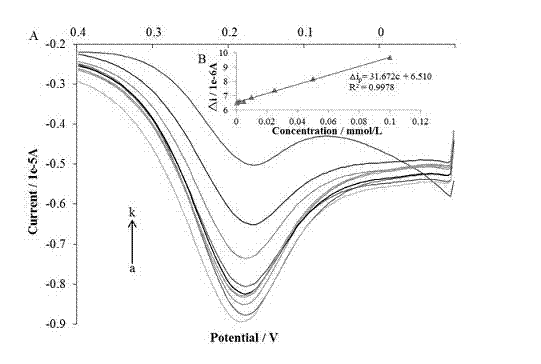Electro-polymerization preparation method of electrochemical sensor for quickly detecting EGCG (Epigallocatechin-3-Gallate)
An electrochemical and electropolymerization technology, applied in the direction of electrochemical variables of materials, etc., can solve the problems that the application research of EGCG molecularly imprinted membrane sensor has not yet been reported, and achieve the effects of fast detection speed, simple operation and fast analysis speed.
- Summary
- Abstract
- Description
- Claims
- Application Information
AI Technical Summary
Problems solved by technology
Method used
Image
Examples
Embodiment 1
[0024] The glassy carbon electrode was polished into a mirror surface with alumina particles of 0.3 μm and 0.05 μm in sequence, and the alumina powder adhering to the surface was rinsed off with distilled water, then ultrasonically washed in ultrapure water and absolute ethanol for 3 min, and cycled 3 times. After washing off the residue on the electrode surface, the electrode was electrochemically activated, that is, the electrode was placed in a solution containing 5 mmol / L K 3 [Fe(CN) 6 ] and 0.2 mol / L KCl in phosphate buffer (pre-filled with nitrogen for 8 min to remove oxygen), and carried out cyclic voltammetry scanning in the voltage range of 0-0.8 V until
[0025] to obtain a stable cyclic voltammetry response. With glassy carbon electrode as working electrode, o-phenylenediamine ( o- PD) is the functional monomer, and potassium chloride is the supporting electrolyte. The three-electrode system was placed in a phosphate buffer solution (pH 5.2) containing 5 mmol / L o...
Embodiment 2
[0030] The glassy carbon electrode was polished into a mirror surface with alumina particles of 0.3 μm and 0.05 μm in turn, and the alumina powder attached to the surface was rinsed with distilled water, followed by ultrasonic cleaning in ultrapure water and absolute ethanol for 5 min, and the cycle was repeated 6 times. Wash away residues from the electrode surface. Afterwards, the electrode was electrochemically activated, that is, the electrode was placed in a solution containing 5 mmol / L K 3 [Fe(CN) 6 ] and 0.2 mol / L KCl in phosphate buffer solution (pre-filled with nitrogen for 10 min to remove oxygen), the cyclic voltammetry scan was performed in the voltage range of 0-0.8 V until a stable cyclic voltammetry response was obtained. With glassy carbon electrode as working electrode, o-phenylenediamine ( o -PD) is the functional monomer, and potassium chloride is the supporting electrolyte. The three-electrode system was placed in a phosphate buffer solution (pH 5.5) con...
Embodiment 3
[0034] The glassy carbon electrode was polished to a mirror surface with 0.3 μm and 0.05 μm alumina suspension suede in turn, and after the alumina powder attached to the surface was rinsed off with distilled water, it was ultrasonically washed in ultrapure water and absolute ethanol for 5 min. Cycle 6 times to wash off the residue on the electrode surface. Afterwards, the electrode was electrochemically activated, that is, the electrode was placed in a solution containing 5 mmol / L K 3 [Fe(CN) 6 ] and 0.2 mol / L KCl in phosphate buffer solution (pre-filled with nitrogen for 10 min to remove oxygen), the cyclic voltammetry scan was performed in the voltage range of 0-0.8 V until a stable cyclic voltammetry response was obtained. With glassy carbon electrode as working electrode, o-phenylenediamine ( o -PD) is the functional monomer, and potassium chloride is the supporting electrolyte. The three-electrode system was placed in a phosphate buffer solution (pH 5.5) containing 10...
PUM
 Login to View More
Login to View More Abstract
Description
Claims
Application Information
 Login to View More
Login to View More - R&D
- Intellectual Property
- Life Sciences
- Materials
- Tech Scout
- Unparalleled Data Quality
- Higher Quality Content
- 60% Fewer Hallucinations
Browse by: Latest US Patents, China's latest patents, Technical Efficacy Thesaurus, Application Domain, Technology Topic, Popular Technical Reports.
© 2025 PatSnap. All rights reserved.Legal|Privacy policy|Modern Slavery Act Transparency Statement|Sitemap|About US| Contact US: help@patsnap.com


